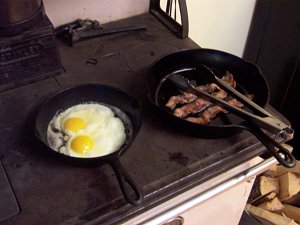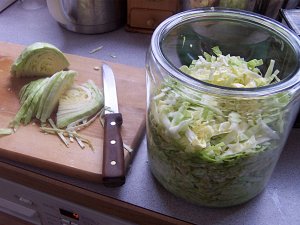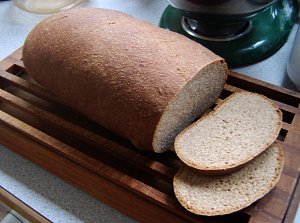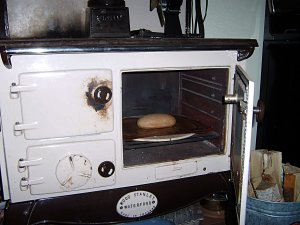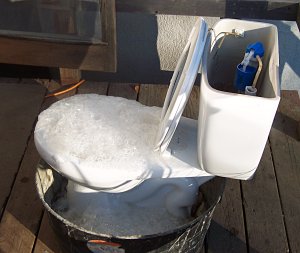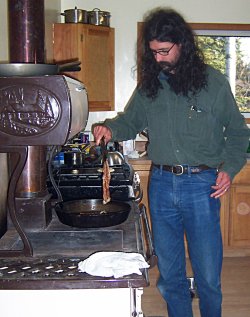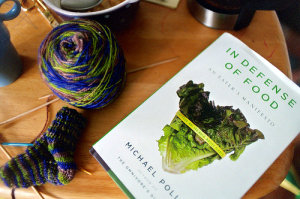
in defense of food. photo by cafemama
Another fantastic book from Michael Pollan. This one is a very quick consideration of what food has become in our society, how it has affected our health, and how we can escape the obvious perils that this diet has caused. The first section considers the rise of “nutritionism,” and if you read his article on the subject from The New York Times Magazine, much of this material will be familiar. The argument is that the discovery of macro- and micro-nutrients has allowed scientists, journalists, and industrial food producers to keep consumers focused on the nutrients in food rather than the food itself. This is important because as food producers began modifying food into food-like substances, they could use the science of nutrition to enrich their food-like substances with what scientists were telling the public they needed. So when you refine whole wheat grains into white flour, you eliminate most of the nutrients from the grains. No problem: just add those nutrients back in. Unfortunately, the evidence suggests that this doesn’t work. Food isn’t just a collection of nutrients, and a loaf of nutrition-enriched bread-like substance made from refined grains, chemical additives and preservatives won’t give you the same benefits of a real loaf of bread made from whole grains, yeast, salt and water.
The second section discusses the “Western Diet,” and how unhealthy it is. He defines the Western Diet as a diet with “lots of processed foods and meat, lots of added fat and sugar, lots of everything except fruits, vegetables, and whole grains” (page 89). As a result of this diet, fortified with all the nutrients and vitamins science tells us we need, two-thirds of Americans are overweight, one-quarter have metabolic syndrome, and the incidence of type 2 diabetes has been going up by 5 percent every year since 1990. The United States is now 45th in the world for life expectancy at birth. The interesting (and hopeful) thing is that the health consequences of this diet can be rapidly reversed by eating differently.
The last section of the book offers some advice on how to modify your own diet in the form of a series of rules. For example, one of the best rules is this one:
Avoid food products containing ingredients that are a) unfamiliar, b) unpronounceable, c) more than five in number, or that include d) high-fructose corn syrup.
This is a tough one to follow. Earlier in the week I went to the supermarket to get hamburger buns, and there were none on the shelf that would be allowed under this rule. All of them had high-fructose corn syrup in them. Short of making my own (which I may try tomorrow), I have no valid choices at the supermarket. All the hamburger buns available don’t really qualify as food.
All the rules are condensed down to one short statement that appears on the cover: “Eat food. Not too much. Mostly plants.” But despite the simplicity of that prescription, reading the book is well worth it. It’s a very quick read, and really brings the point home that we need to think more critically about what we’re eating in this country.
Not getting tired of cooking food on the wood stove yet, and I’m not tired of showing you how cool it is either…
In addition to baking some bread from Reinhart’s whole grain bread book (see my review here), I finally got around to dealing with the cabbage we grew in our garden at the old house. We planted ten plants and all of them produced, but the cabbages weren’t all that large (“bigger than a softball, smaller than a bowling ball”). Today I chopped them up, salted and pressed them into what will become sauerkraut in a couple months. Last year’s sauerkraut was a little mild, so I’ll let it go longer this year. The glass container holds a gallon, and it’s about 80% full with this year’s production. Not bad, and probably as much sauerkraut as I’ll be able to eat this year. If it comes out OK, I may need to investigate corning the brisket from our side of Delta beef.
Thinking of Reuben sandwiches on homemade whole grain rye bread. Mmm…
A couple weeks ago I finished reading Peter Reinhart’s Whole Grain Breads, and baked my first loaf. I chose the whole wheat sandwich loaf even though I much prefer hearth breads because it was the teaching recipe that all the other recipes are based on. The bread was fantastic; sweet, not too dry, and with a lot of wheat flavor. And, best of all for a homemade sandwich bread, it lasted until Friday without losing any of it’s flavor or character.
I have also made the whole wheat pizza dough twice, and it’s equally good. Our previous dough recipe was Cook Illustrated’s 75-minute pizza dough, which tastes pretty good, and has sufficient gluten development to form a pizza crust, but once it’s baked with sauce, toppings and cheese, it’s not really strong enough to handle picking up the slices. The whole wheat dough was sturdy enough, and again, it had the same sweet wheat flavor and nice texture as the sandwich loaf. The recipe in the book makes five individual pizzas, which was more dough that I needed for a single large pizza (I reduced the recipe by 25% the second time around and it was perfect) so I used the leftover dough the next day to bake a small loaf in the wood stove oven. The oven was around 425°F, which is a little hotter than the baking temperatures in the book, and I should have rotated the loaf half-way through because the oven heat isn’t very even, but the loaf came out great.
Since then I’ve made whole wheat hearth bread, which was tasty, but lost some of it’s height when I transferred it to the baking stone (I’ve got a Super Peel coming, which should help with this problem), and oat bran broom bread. Both came out great tasting with excellent crumb, and still had great texture and flavors when I finished the loaf.
The method used in almost all the breads in the book is different than any of the techniques I’ve seen in other books. Most quality breads have a long pre-ferment, either using sourdough or a lightly yeasted dough that rises slowly overnight and is mixed in on baking day, and usually feature low amounts of yeast which require long several-stage fermentation on baking day to develop gluten and the yeast. Reinhart’s method for developing the dough is to use a lightly yeasted pre-ferment as in the other recipes, plus an soaker that rests overnight at room temperature. These two doughs form the majority of the final dough. They’re mixed on baking day with the rest of the ingredients, and a relatively large amount of yeast. Since the flavors and structure has already been developed in the two overnight doughs, there’s no reason for a long fermentation on baking day. The technique also works wonders on whole grain flours, which can result in dense loaves in traditional recipes.
The result is bread with all the flavor and keeping potential of traditional recipes but you can use much higher percentages (like 100%) of whole grain flours with greater confidence that the bread will turn out, and best of all, baking day becomes a two hour process, rather than a four to six hour, multiple stage, slow fermentation procedure. I’m not going to abandon my other bread books, but it’s great to have more techniques at my disposal when deciding what kind of bread to make. And Reinhart can be commended for all the research and testing he did to develop the methods in this book.
I highly recommend Whole Grain Breads to anyone who is really interested in bread baking, especially if you’re ready to jump onto the whole grain bandwagon.
Things are slowing down as the house is ready for winter and almost everything is gone from the old place. A couple more trips this weekend and I hope we’ll be done moving. We haven’t done much unpacking, but there will be plenty of time for that now that it’s starting to get cold.
After the sunrise this morning I took Nika out on one of the trails on the other side of the road from our driveway. There’s a trail that goes along the road, and off that is a trail that goes mostly east up over the ridge, which is where I took Nika. It’s about ¾ of a mile to where the trail intersects what looks like it might be a road, but since I didn’t know where I was, I turned around and came back. You can sort of see what the environment looks like from the photo on the right. The forest was dark and the sky was lit with the sunrise, so it was hard to get a good photo.
The other photo shows the toilet repair I did earlier today. The toilet didn’t flush “all the way,” even when there wasn’t anything but liquid in the bowl. I was worried that it was installed incorrectly, but the plumber that came to charge our glycol lines said it was just scale inside the toilet. He suggested getting some hydrochloric acid and letting it dissolve the scale by running it through the toilet. But since we’ve got our own sewage treatment plant that needs to be treated gently (the instruction manual says we need to treat it like a pet, since it's a living system), I pulled the toilet out of the house and ran acid through it from the top tank into the bowl. I’m glad I did it outside, since the reaction released some really nasty smelling (and probably poisonous) gases. The photo is what happened when I neutralized the acid with a couple boxes of baking soda. The acid came with a pH testing kit to verify the acid was neutralized before disposing of the solution.
After all that, I wiped it down, installed a new wax ring, and screwed the toilet back in place. Turns out the plumber was exactly right: now it flushes like a toilet should.
I also made some time to try out a recipe from Peter Reinhart’s Whole Grain Breads. I finished reading the book last night and prepared the soaker and biga for the basic whole wheat sandwich loaf. Reinhart calls his new baking method a delayed fermentation, “epoxy” method where a large percentage of the dough is prepared in advance. Half of it is a traditional pre-ferment, with either a small amount of yeast added, or is a sourdough; and the other half is a soaker or mash that sits overnight, allowing enzymes to develop flavor and enhance the dough structure and fuel for fermentation. On baking day, you mix the two blobs of dough with the remaining flour, yeast and other ingredients, knead and bake it. Most of the gluten and flavors are developed overnight, so even though the entire process takes more than one day, it involves less effort on each day.
It’s just out of the oven now. Tomorrow, when the bread has cooled, I’ll have a report on how it turned out, but it rose nicely, and I got enough oven spring that the loaf is quite round in cross section.
It was another cold day this morning, and since we moved all the split firewood from our old house yesterday, we decided to make a fire in our wood burning cookstove. We got the replacement firebox parts earlier in the week, and they slid right into place. We’ve got about a cord stacked in the woodshed, and another cord of spruce that’s been cut, but not split yet. Hopefully the split wood will last long enough to allow the spruce to dry once I’ve chopped it. With everything else going on, I haven’t had any opportunity to go logging, or even deal with the wood I got earlier in the spring.
The Stanley fired right up, and within about fifteen minutes the top cook surfaces ranged from 700°F above the firebox, to 200°F on the cooking plates on the right side of the stove. The oven peaked at 180°F after 45 minutes, but by then the house was already warm and I’d burned all the wood I brought into the house, so I didn’t let it go any longer. I’m not exactly sure how to use the flue controls on the stove to regulate the cooktop and oven temperatures, but it was easy to get the fire started, and then cinched down to burn slowly.
Since today was pancakes and bacon day, and the cookstove was already warm, I tried cooking the bacon on the wood stove. Like the electric stove six months ago, and our new gas stove last week, the wood burning stove heated the pan evenly and the bacon came out perfectly. The cooktop could have been hotter and the bacon would have browned a bit more than it did, but for my first attempt at renewable energy cooking, I’ll mark this one down as a complete success.
Now back to moving. Sigh.
